





As a founding employee of Gardener's Supply, I wore many different hats over the years. Currently, I have my own company called Johnnie Brook Creative. The gardens around my home in Richmond, VT, include a large vegetable garden, seasonal greenhouse, cutting garden, perennial gardens, rock garden, shade garden, berry plantings, lots of container plants and a meadow garden. There's no place I'd rather be than in the garden.
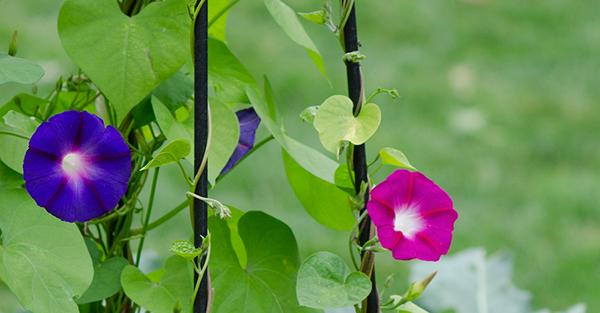
While they support your plants, decorative trellises can also provide an interesting focal point in the garden.
SPEND a week or two touring British flower gardens, and you'll come home with a whole new appreciation for how climbing plants can enhance a garden. Everywhere you turn the walls are covered with roses and climbing hydrangeas; the trees and shrubs are threaded with clematis; pergolas, arches and fences are draped in honeysuckle and ivies; obelisks and tripods are woven with sweet peas, morning glories and thunbergia; passion vines, jasmine, mandevillea and bougainvillea fill pots and planters of every shape.
Here in the U.S., few gardeners take advantage of these wonderful plants. Possibly it's because so few of us have the structures to properly support them. With that in mind, here is a brief run down of the options and how you can put them to work in your own garden.
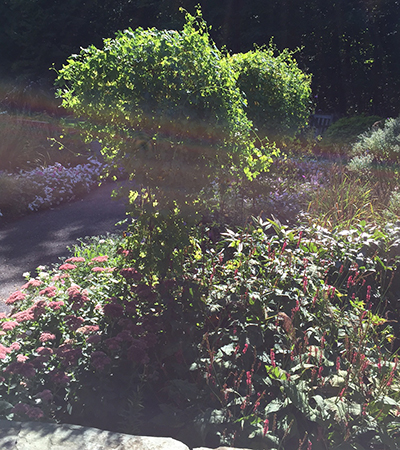
Fast-growing annual vines have completely covered the sturdy, freestanding wire trellises in this garden.
A couple things to consider first:
Whatever supports you use, make sure they are sturdy — much sturdier than you think they need to be. By the time August comes around, that trellis or tripod may be holding 50 to 100 pounds of foliage, and having it topple in a thunderstorm is heartbreaking. Supports should be made of weatherproof materials (such as galvanized or plastic-coated wire, painted or treated wood), especially if you are planting a perennial vine.
Also think about whether you want the support — as well as the plant — to be a decorative garden feature, or if the support's only job is to show off the plant. Decorative plant supports can serve as interesting focal points in the garden (arbors marking an entryway, an obelisk marking the end of a pathway), or can provide a sense of enclosure by screening views and/or delineating boundaries (fences, trellis panels, walls, pergolas).
And last, think about what kinds of plants you want to grow. A climbing rose requires a different type of support than a sweet pea; pole beans need a different support from a tomato or cucumber plant. To learn more about which types of supports suit which types of plants, read How Plants Climb.
Here are some choices, starting with decorative and ending with the functional:
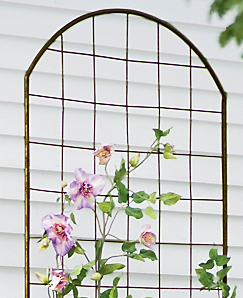
Jardin Flower Trellis
Walls
Not many of us have beautiful 10-foot-high walls of aged brick around our gardens. But you might consider growing plants on one wall of your house, the wall of an outbuilding, or the "wall" of a neighbor's fence. There are a couple options for training plants against a wall. Clinging plants like Boston ivy, can attach themselves to almost any wall with no other support necessary. Most other plants will need to attach themselves to a wall-mounted trellis or a system of wires and eye bolts.
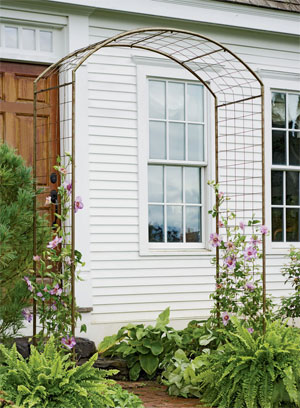
Jardin Rose Arch
Arches
These structures can add distinctive flair to your garden, no matter what the season. Design and placement are critical. Spend some time in your garden determining what style and scale structure would be compatible with your house and landscape. These structures are most often made of wood, which can be painted or stained to resist the elements. Steel and plastic versions are also available, and are a smart choice if the style suits your garden.
Flat trellises
These are often used to define a space or provide a sense of privacy. They may be freestanding, or can be anchored to a wall or posts. Sometimes permanently located, they are also relatively easy to move around the garden if you want to try out different effects. Examples of flat trellises would be wood lattice panels, metal trellises of various kinds, and those made of plastic mesh.
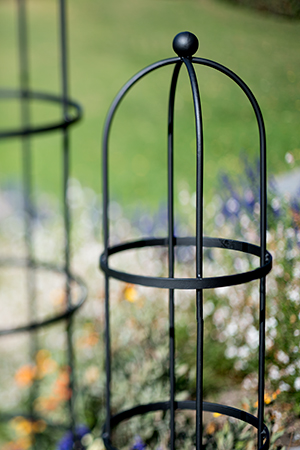
A freestanding trellis creates a focal point in a garden.
Obelisks, tripods and teepees
Both functional and decorative, these structures add a strong vertical element that can serve as a focal point in the garden. Like exclamation points, they're most effective when not overused. Make sure the structure is tall enough to support the type of plant you want to grow. Scarlet runner beans and vigorous varieties of morning glories, for instance, want a support that's 8 to 10 feet tall; they'll quickly overpower a 4-foot tripod. Bamboo canes make inexpensive and attractive teepees for the vegetable garden.
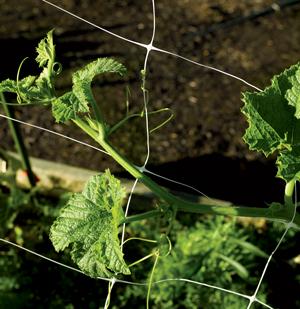
Nearly Invisible Netting can be used to turn nearly any surface into a climbing wall for plants.
Fencing and porches
There are climbers to suit almost every type of fencing you can imagine—even chain-link fences. Climbing roses look beautiful draped over a post-and-rail fence. When they get a little help from strings or plastic netting, sweet peas look terrific growing against a picket fence. Porch railings and banisters can be wrapped with plastic trellis netting.
Twiggy branches
Ubiquitous in Britain, where they are usually called "pea sticks" because they are ideal for supporting sweet peas. Collect some branches about 3 to 5 feet in length, and then simply push them into the soil. The more tiny twigs, the better. Branches from shrubs often work better than trees. Why do the Brits love them so much? They're free! But they're also quick to install, almost invisible when covered with vines, and can be composted at year's end.
Cages and ladders
Vegetable supports
are usually long on function and short on style. What's important is that they are sturdy and made of durable materials, tall enough for the plants they'll support, are easy to store away at season's end.
One last idea from England that's super-easy: Try growing a climber up through an existing shrub or tree. Clematis are ideal for this job. Years ago, I planted Clematis 'Henryii' at the base of a white birch. At first I had to help it up with some strings, but it quickly found its way into the branches above and every year, it puts on a stunning display with its huge white flowers. Clematis are also happy to thread their way through shrub roses and lilacs. Another plant that I often saw growing up through hedges was Tropaeolum, also known as canary creeper. If your climate is temperate enough, passion vines are also good weavers.
So don't let the Brits have all the fun. Try combining a couple of these supports with a some interesting climbing plants and let them take your garden to new heights.
Copyright © www.100flowers.win Botanic Garden All Rights Reserved